Home
> Lead
> Lead Harmony
This lesson is about finding a suitable starting point for building your lead harmony and developing it around some common chord movements.
The video below will get you started, and then further down you can grab your practice tracks and learn more about building lead harmony effectively, using the most common scales.
In the video I showed you the most common scale harmonization intervals - 3rds, 4ths and 6ths. Below I've picked out several scales for you to harmonize. There are tabs below each scale showing you how we could harmonize on a C root, but try and work it out yourself before you jump to the answer! You can then jam out your ideas using the practice tracks below each scale.
First, the major scales. Each practice track is in the key of C major. This means we position the below patterns on a C root (R - that would be the 8th fret on the E string). But make sure you practice harmonizing in different keys...
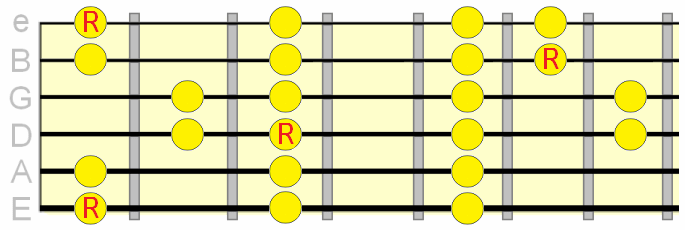
Harmonizing in 3rds

Harmonizing in 4ths

Harmonizing in 5ths

Harmonizing in 6ths
6ths are slightly different as we have to skip a string. If you collapse back the finger on the lowest string you can touch and mute the string in between the two notes.

Practice Tracks
 C major (right click and "save as"
to download)
C major (right click and "save as"
to download)
 C major / F major (I - IV)
C major / F major (I - IV)
 C major / D minor (I - ii)
C major / D minor (I - ii)
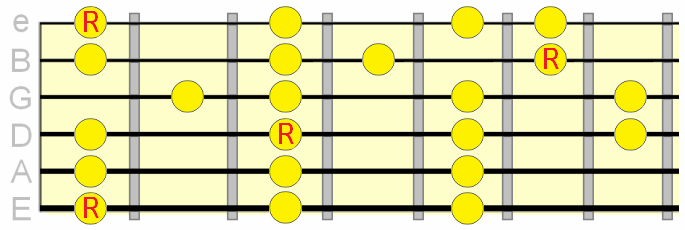
When playing over the C major track, listen to how Mixolydian changes the overall colour of the harmony compared to the major scale - even though there's only one note difference between the two scales. I've highlighted the differing harmonies in blue on the tabs below. Switch between the two to really internalize this difference - that's some powerful ear training!
Harmonizing in 3rds

Harmonizing in 4ths

Harmonizing in 5ths

Harmonizing in 6ths

Practice Tracks
 C major (right click and "save as"
to download)
C major (right click and "save as"
to download)
 C major / G minor
C major / G minor
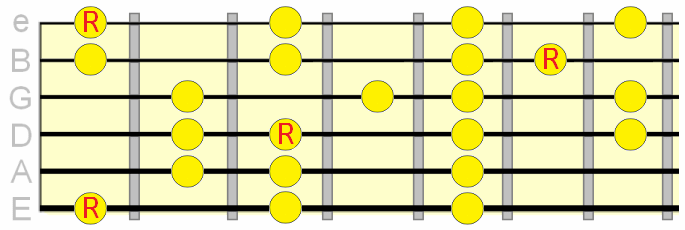
Again, just one note difference in relation to the major scale, but with a big change in sound. A very pretty scale to harmonize!
Harmonizing in 3rds

Harmonizing in 4ths

Harmonizing in 5ths

Harmonizing in 6ths

Practice Tracks
 C major (right click and "save as"
to download)
C major (right click and "save as"
to download)
 C major / D major
C major / D major
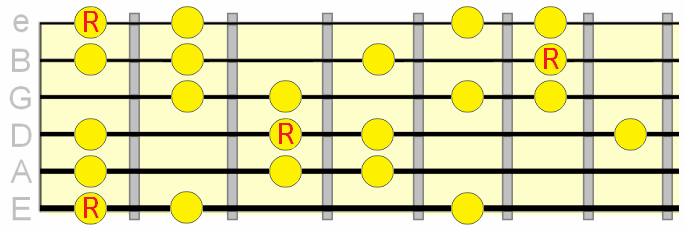
This scale is traditionally used in styles such as flamenco and Gypsy music, but you'll also hear it frequently used in pop, rock and especially metal. Great as a more tense alternative to Mixolydian.
Harmonizing in 3rds

Harmonizing in 4ths

Harmonizing in 5ths

Harmonizing in 6ths

And now for some minor scales. Download the A minor chord track here and position the below patterns on an A root (e.g. 5th fret on the E string)...
Practice Tracks
 C major (right click and "save as"
to download)
C major (right click and "save as"
to download)
 C major / Db major
C major / Db major
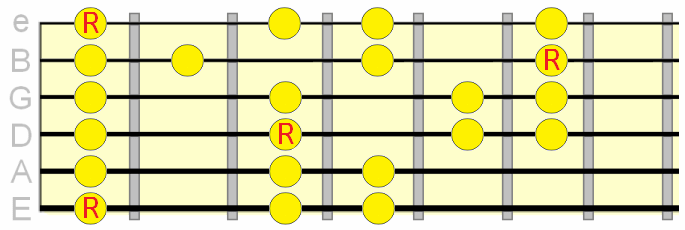
Most minor key songs fall within this scale. If in doubt, try natural minor (along with pentatonic of course) first!
Harmonizing in 3rds

Harmonizing in 4ths

Harmonizing in 5ths

Harmonizing in 6ths

Practice Tracks
 A minor (right click and "save as"
to download)
A minor (right click and "save as"
to download)
 A minor / F major
A minor / F major
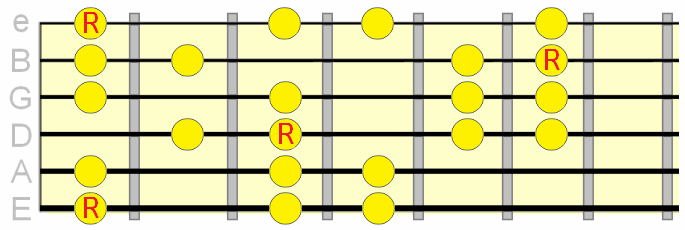
Another common minor key scale that differs from natural minor by one tone (the 7th). Considered a darker sound by many. I've marked the differing harmonies in blue.
Harmonizing in 3rds

Harmonizing in 4ths

Harmonizing in 5ths

Harmonizing in 6ths

Practice Tracks
 A minor (right click and "save as"
to download)
A minor (right click and "save as"
to download)
 A minor / E major
A minor / E major
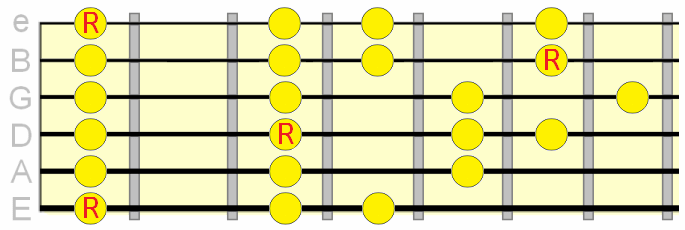
Tip: great for blues when combined with minor pentatonic and its flat 5 variation.
Harmonizing in 3rds

Harmonizing in 4ths

Harmonizing in 5ths

Harmonizing in 6ths

Practice Tracks
 A minor (right click and "save as"
to download)
A minor (right click and "save as"
to download)
 A minor / D major
A minor / D major
In later parts, I plan to show you how to combine harmonic and melodic movements in your lead playing, right across the neck. In the meantime, I hope you enjoyed the lesson and the new dimension it offers your lead playing!
Share your thoughts...
Have any questions, thoughts or ideas about this lesson? Let us know using the comments form below.
Guitar Lead Harmony - Add Depth to Your Solos
Lead playing doesn't always have to involve single note melodic runs. You can introduce deeper harmonic expressions by playing around with two or three simultaneous notes over the chord sequence.This lesson is about finding a suitable starting point for building your lead harmony and developing it around some common chord movements.
The video below will get you started, and then further down you can grab your practice tracks and learn more about building lead harmony effectively, using the most common scales.
Harmonizing Scales Using Double Stops
Scale harmonization is a great way to explore a particular scale's musical flavour. The concept is simple - instead of playing through the scale note by note, we play through it two notes at a time. Two notes played together on guitar like this is known as a double stop.In the video I showed you the most common scale harmonization intervals - 3rds, 4ths and 6ths. Below I've picked out several scales for you to harmonize. There are tabs below each scale showing you how we could harmonize on a C root, but try and work it out yourself before you jump to the answer! You can then jam out your ideas using the practice tracks below each scale.
First, the major scales. Each practice track is in the key of C major. This means we position the below patterns on a C root (R - that would be the 8th fret on the E string). But make sure you practice harmonizing in different keys...
Major Scale

Harmonizing in 3rds

Harmonizing in 4ths

Harmonizing in 5ths

Harmonizing in 6ths
6ths are slightly different as we have to skip a string. If you collapse back the finger on the lowest string you can touch and mute the string in between the two notes.

Practice Tracks
 C major (right click and "save as"
to download)
C major (right click and "save as"
to download) C major / F major (I - IV)
C major / F major (I - IV) C major / D minor (I - ii)
C major / D minor (I - ii)Mixolydian

When playing over the C major track, listen to how Mixolydian changes the overall colour of the harmony compared to the major scale - even though there's only one note difference between the two scales. I've highlighted the differing harmonies in blue on the tabs below. Switch between the two to really internalize this difference - that's some powerful ear training!
Harmonizing in 3rds

Harmonizing in 4ths

Harmonizing in 5ths

Harmonizing in 6ths

Practice Tracks
 C major (right click and "save as"
to download)
C major (right click and "save as"
to download) C major / G minor
C major / G minorLydian

Again, just one note difference in relation to the major scale, but with a big change in sound. A very pretty scale to harmonize!
Harmonizing in 3rds

Harmonizing in 4ths

Harmonizing in 5ths

Harmonizing in 6ths

Practice Tracks
 C major (right click and "save as"
to download)
C major (right click and "save as"
to download) C major / D major
C major / D majorPhrygian Dominant

This scale is traditionally used in styles such as flamenco and Gypsy music, but you'll also hear it frequently used in pop, rock and especially metal. Great as a more tense alternative to Mixolydian.
Harmonizing in 3rds

Harmonizing in 4ths

Harmonizing in 5ths

Harmonizing in 6ths

And now for some minor scales. Download the A minor chord track here and position the below patterns on an A root (e.g. 5th fret on the E string)...
Practice Tracks
 C major (right click and "save as"
to download)
C major (right click and "save as"
to download) C major / Db major
C major / Db majorNatural Minor

Most minor key songs fall within this scale. If in doubt, try natural minor (along with pentatonic of course) first!
Harmonizing in 3rds

Harmonizing in 4ths

Harmonizing in 5ths

Harmonizing in 6ths

Practice Tracks
 A minor (right click and "save as"
to download)
A minor (right click and "save as"
to download) A minor / F major
A minor / F majorHarmonic Minor

Another common minor key scale that differs from natural minor by one tone (the 7th). Considered a darker sound by many. I've marked the differing harmonies in blue.
Harmonizing in 3rds

Harmonizing in 4ths

Harmonizing in 5ths

Harmonizing in 6ths

Practice Tracks
 A minor (right click and "save as"
to download)
A minor (right click and "save as"
to download) A minor / E major
A minor / E majorDorian

Tip: great for blues when combined with minor pentatonic and its flat 5 variation.
Harmonizing in 3rds

Harmonizing in 4ths

Harmonizing in 5ths

Harmonizing in 6ths

Practice Tracks
 A minor (right click and "save as"
to download)
A minor (right click and "save as"
to download) A minor / D major
A minor / D majorIn later parts, I plan to show you how to combine harmonic and melodic movements in your lead playing, right across the neck. In the meantime, I hope you enjoyed the lesson and the new dimension it offers your lead playing!
| Was this
helpful? Please support this site. I really appreciate it! |
Stay updated
and learn more Sign up to the newsletter for updates and grab your free Uncommon Chords book |
Share your thoughts...
Have any questions, thoughts or ideas about this lesson? Let us know using the comments form below.









